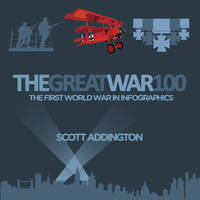When I first heard about this book I said to myself well, that’s different! It most certainly is. We last saw Scott Addington with his excellent layman’s guide to World War One and he has taken his drive to find a simple way to explain a very complicated conflict to a whole new level here.
The book is striking in appearance and presents the grim statistics and a wealth of important facts in the clearest of styles. There are no photographs or blocks of in-depth text. Relying entirely on imagery made up of graphics, the book is, in some ways; not far removed from the sort of stuff we see television news presenters sharing as a backdrop while they cling on totheirtablet computers at all costs.
The book is inevitably a fast read and easy to follow and I really like the concept, believing it would work well in an educational environment. There is lot to like here.
But, regardless of this, I found several problems that irritate me. The diagram for the SMLE is the later model synonymous with World War II and post war National Service era. The naval chapter where ships are sometimes called boats(something my naval ancestors would spit at!)has a polyglot of silhouettes of modern or much more recent ships representing the classes of the Great War. While I don’t believe for one minute that what appears to be the profile of an Arleigh Burke class destroyer representing a dreadnoughtis the end of the world, these things niggle at me.
There are others and these are details that let the overall scheme down and my gun devotee son, for one, was unimpressed. But the submarines and much of the aviation derived content works brilliantly. I really liked the section on medals.
To be fair, finding suitable reference for the absolutely correct images may not have been straightforwardfor the designers and infographics are, surely, meant to be representative not perfect copies. The overall concept is original and well conceived and the author has concentrated on the important things with his quick to read and informative text.
The centenary of the war is here and now and the challenge to engage the young must be a real one for educators. I think the book would satisfy the inquisitive minds of casually observing youngsters or even many adults for that matter. It isn’t aimed at the seriously devoted military history buffs who have been there and bought the t-shirt and much of what I find difficult would probably sail over the heads of a general audience.
So, niggles aside, this is a clever concept that needs a bit of tidying to keep me and my anorak happy. These details matter. Someone has just pointed out to me that a book I recently reviewed and admired had the wrong image on the cover for the period in question and I never even noticed. Like anything subjective, reviewing is not a precise science but I hope I get the balance right.
I really want to like this book but, for the reasons stated I can’t quite force myself. My school essays were often marked by a teacher using red ink saying could do better; see me. That’s kind of how I feel about things.
Reviewed by Mark Barnes for War History Online
THE GREAT WAR 100
The First World War in Infographics
By Scott Addington
The History Press
ISBN:978 0 7524 8639 0
